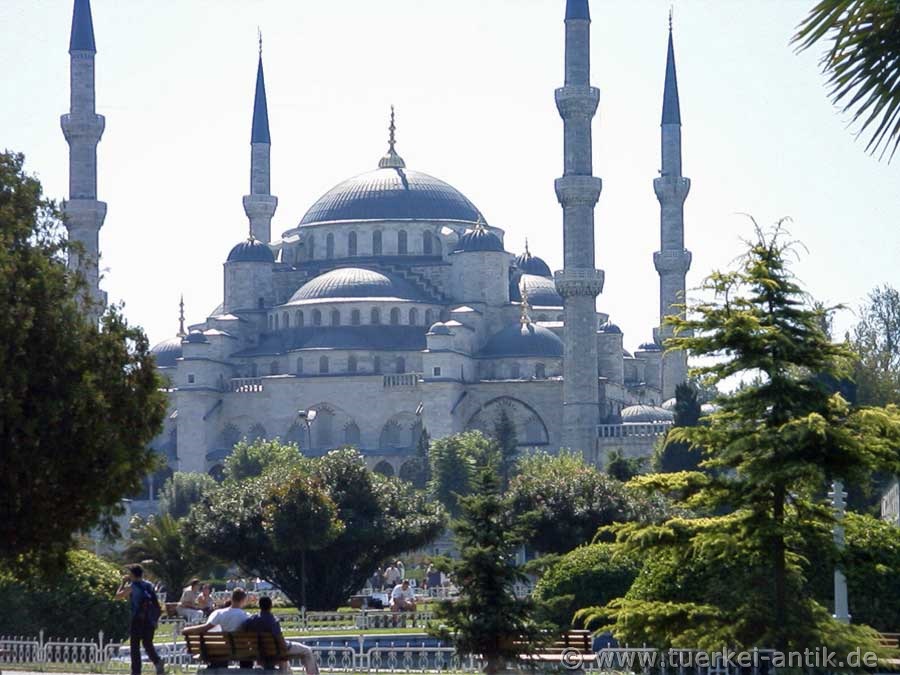 |
| Istanbul in Thrace | |||
 |
|
||
| The Sultan Ahmed Mosque | |||
|
The Sultan Ahmed Mosque (Turkish Sultanahmet Camii) in Istanbul was commissioned by Sultan Ahmed I in 1609 and built until 1616, one year before the death of the Sultan, by Sinan disciple Mehmet Ağa
Today it is Istanbul's main mosque and a major work of Ottoman architecture. In Europe it is known as the Blue Mosque because of its richness of blue-white tiles decorating the dome and the upper part of the walls.
|
|||
|
|
|||
| The prayer room | |||
|
The prayer room is 53 m long and 51 m wide and is almost square. The main dome has a diameter of 23.5 m and is 43 m high. It is supported by four pointed arches and four flat gussets, which again rest on four huge, 5 m thick columns. 260 windows illuminate the interior. The colourful glass panes are modern replicas of the original 17th century glass. |
|||
|
|
|||
| The Suleymaniye Mosque | |||
|
The Süleymaniye Mosque (in Turkish Süleymaniye Camii) is one of the great mosques in İstanbul. It was commissioned by Sultan Suleyman the Magnificent in a very short construction period between 1550 and 1557 and is an important work of the architect Sinan. The mosque is located in a courtyard measuring 216 by 144 metres, which also includes the doors (mausoleums) and a cemetery. The outside dimensions, including the inner courtyard, are 108 by 73 metres. The inside of the mosque is 59 metres long and 58 metres wide. The main dome is 53 meters high and has a diameter of 27.25 meters. The mosque of Sultan Selim II in Edirne and the Sultan Ahmed Mosque in Istanbul reached similar proportions. Sinan had 64 clay vessels, each 0.5 metres in diameter, installed in the central dome. This gave it excellent acoustics. The Sultan Suleyman Mosque was the most ambitious foundation of the Sultan Suleyman, but he also had remarkable public buildings built in Southeast Europe, Anatolia, Mecca, Medina, Damascus, Jerusalem, Baghdad etc. to demonstrate and legitimise his power. |
|||
|
|
|||
| The south entrance of the Dolmabahce Palace | |||
|
The Dolmabahce Palace ("Palace of Full Gardens") is located on the European shores of the Bosphorus in Istanbul and has been the residence of the Sultan since the middle of the 19th century.
The building measures 600 meters in length, has an area of 45,000 m², 46 halls, 285 rooms, six hamam and 68 bathrooms. The court moved out of the old Topkapı palace in 1856. After the removal of the Sultan, the Dolmabahce Palace Mustafa Kemal served as the seat of government until the capital moved to Ankara and later as Istanbul's residence. No significant alterations were made for this purpose. Mustafa Kemal Atatürk died there on 10 November 1938 at 9:05 a.m. Today the Dolmabahce Palace is open to the public and a popular destination for domestic and foreign tourists. However, it is still used for representative state occasions, such as state visits. |
|||
|
|
|||
| The Topkapı Palace | |||
|
The Topkapı palace was for centuries the residence and government seat of the sultans as well as the administrative centre of the Ottoman Empire. Construction began soon after the conquest of Constantinople (1453) by Sultan Mehmed II. The palace, begun in 1459 and initially consisting of two courtyards (today 2nd and 3rd courtyards), was completed in 1468. Parts of the Byzantine Mangana Palace were built over.
With an area of over 69 hectares and up to 5000 inhabitants, the palace was a city in its own right. It is divided into four courtyards, each of which is reached through its own gates. Located on a headland, it offers unparalleled panoramic views of Istanbul, the Bosporus and the Golden Horn. |
|||
|
|
|||
|
The "Monument of the Republic" erected in 1928 on Taksim Square |
|||
|
|
|||
|
Taksim Square is an important traffic junction in Istanbul.
|
|||
|
|
|||
|
The tram on the İstiklal Caddesi |
|||
|
|
|||
|
The historic tram (Nostaljik Tramvay), which runs from Taksim Square along the İstiklal Caddesi to the top station of the Tünel, is more of a tourist attraction. |
|||
|
|
|||
| Funicular Tünel, valley station in Karaköy district | |||
|
The Tünel is an underground funicular railway in the European part of Istanbul and, opened in 1875, is considered the oldest permanent funicular railway in Europe. At the same time, it is the second oldest underground railway in the world after the London Underground. The train climbs 61.55 m in a parabolic curve and travels at a distance of 606.50 m. The subway is only in the sense that it is run underground, the drive technology is that of a pure funicular. In this respect, it is one of the shortest subways in the world. It connects the districts of Karaköy and Beyoğlu. At the top station the tram line starts along the İstiklal Caddesi to Taksim Square. |
|||
|
|
|||
|
The German Fountain |
|||
|
The German Well (Turkish: Alman Çeşmesi) is a pavilion-like well construction at the northern end of the Hippodrome.
|
|||
| Photos: @chim | |||
| Translation aid: www.DeepL.com/Translator | |||
| Source: Wikipedia and others | |||
|
|
|||

